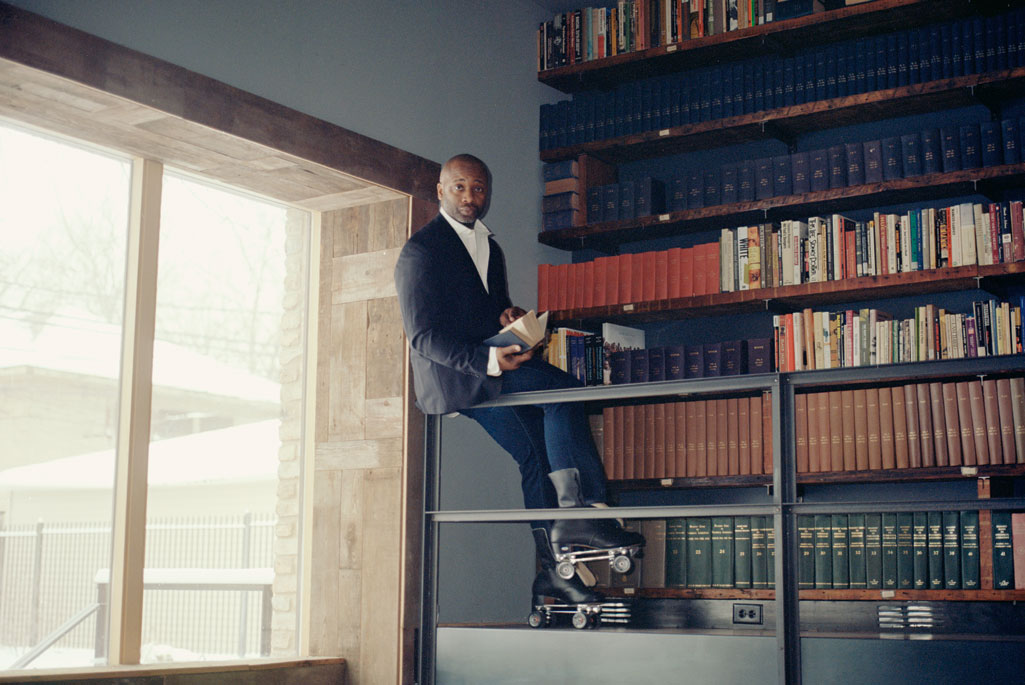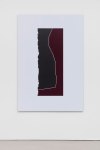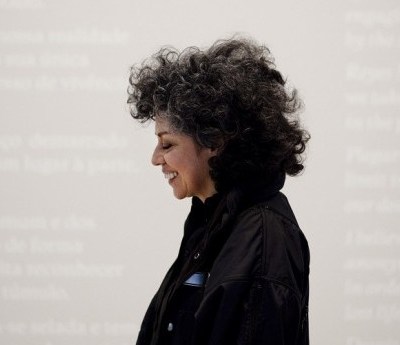Theaster Gates is best known for the regeneration project he initiated in the South Side of Chicago. Such social engagement is crucial to his work, which encompasses everything from abstract painting to musical improvisation
As the January rain washes the windows of Regen Projects in Los Angeles, Theaster Gates, dressed in a blue knee-length kaftan over jeans, is relaxed and buoyant, seemingly unfazed by the pressures of the year ahead. The finishing touches are being made to ‘But to Be a Poor Race’ (14 January–25 February), Gates’ debut exhibition with the gallery. In early March he will open a new body of work, ‘The Minor Arts’, in the recently renovated Tower Gallery of the National Gallery of Art in Washington D.C. The following month, in Helsinki, he will headline the IHME Contemporary Art Festival, where he will perform with his improvisational music ensemble, The Black Monks of Mississippi, part of a larger project for IHME that Gates is calling The Black Charismatic. In June, he unveils a new permanent installation for the sculpture garden of the Walker Art Center, Minneapolis.
The Archive House at Dorchester Projects, Chicago (2012). Photo: © Sara Pooley; Courtesy White Cube; © Theaster Gates
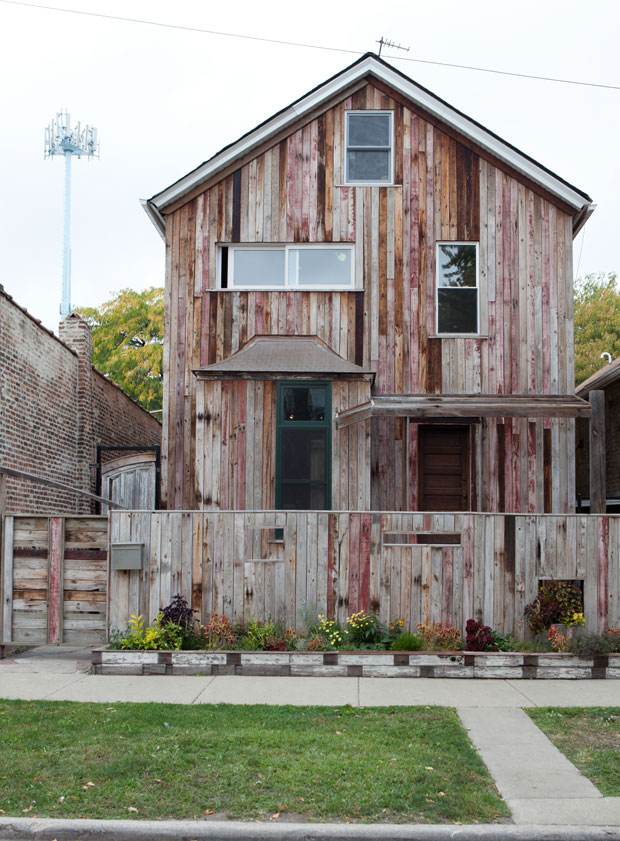
Gates delivers a line – or a version of a line – that I know he has delivered many times, though he makes it sound as if it is crafted for me: ‘I don’t want to just buy a building, I want to make a building.’ Gates is referring to Dorchester Projects, the urban regeneration programme that he has instituted in the South Side of Chicago. He purchased his first house at 6918 South Dorchester Avenue in 2006, and then in 2008 bought the house next door. Since then he has bought (or has been given) 32 abandoned or semi-derelict properties in the Grand Crossing neighbourhood, and used his skills as an artist, and the skills of the often underemployed people around him, to refurbish them and convert them into low-cost housing for artists and creative facilities available to the local community.
In 2013, Gates staged a participatory exhibition at Philadelphia’s Fabric Workshop and Museum whose title has become something of a catchphrase: ‘To Make the Thing that Makes the Things’. Gates provided potters’ wheels, kilns and other equipment for local artists to make pots, bricks, and textile-based objects in the gallery. ‘Making the thing is cool,’ he later said, ‘but to be able to make the thing that makes the thing is supercool.’
At Regen Projects, Gates is talking about buildings, not pots. ‘I don’t want to make a building and have to go somewhere else to get raw material because we don’t make Gypsum board, and we don’t make bricks, and we don’t make lumber. I want to manage all of that,’ he says. ‘I want to be able to say, “Yeah, we can just make our own bricks.”’ The sentiment, he explains, is both symbolic, within the context of the art gallery, but also a reality he dreams about at night.
‘I want to employ a thousand people. And I think if I start a brick manufacturing company, I might be able to do that. And if I had my own bricks, then I could build Thelma’s new building in New York,’ referring to the forthcoming new building, designed by David Adjaye, for director Thelma Golden’s Studio Museum in Harlem.
‘I could build the President’s new library.’ Obama spoke at a fundraiser at the Stony Island Arts Bank last October, and Gates sits on an advisory board for the design of his presidential library, to be built on Chicago’s South Side and known as the Obama Center. Golden is on the board of the Obama Foundation itself. I ask Gates if it is true, that his bricks will be used for these projects. ‘They are things that my heart longs for,’ he says earnestly, and a little evasively. ‘I have to start here, I have to believe, and have a launching place for believing in things. The gallery becomes a space where I can do that.’ And in quiet triumph, he gestures to a low stack of 100 thin black bricks on the gallery floor. ‘These are my bricks.’
He tells me how he approached a brick manufacturer in North Carolina who was willing to work with him on a batch of ‘prototypes’. When the factory produces an order of coloured bricks, it usually has a quantity of leftover coloured clay that it has to dispose of. Gates persuaded it to give him this surplus material, place it in a hopper with black dye and magnesium oxide, and then form his own design of brick, 11 inches long and an inch and a half high. The unprepossessing stack in the gallery is called Study for Pavillion (2017), its title referring to a permanent artwork that Gates has been commissioned to make in the outdoor sculpture garden of the Walker Art Center in Minneapolis – a circular black brick temple provisionally titled Black Vessel for Two Saints. The production of these bricks was a trial, he emphasises. ‘It will happen in Chicago.’
Gates has a way of speaking that can make you feel like you’re in the presence of someone with a gift for making dreams become reality. It is a quality shared by community leaders the world over, something often undersold as charisma, as if it were some kind of confidence trick. Encountered in its purest form, however, it is so much more than that: it is the ability not only to convince others of the potential for change, but to leverage that shared conviction to actually bring about that change.
Ground Rules (Free throw possibility) (2014), Theaster Gates. Photo: © White Cube (Ben Westoby); © Theaster Gates
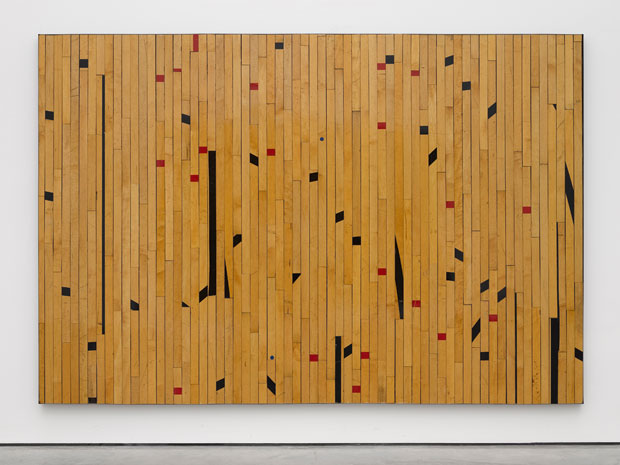
Gates is best known for his commitment to the revitalisation of Grand Crossing and of the South Side more broadly. He is also known for funding his real-estate investments in this neighbourhood partly through the artworks that he sells in galleries – notably vertical stripe paintings made from the wooden floorboards of school gym floors (sourced from condemned Chicago public schools) or canvas fire hoses (in reference to their brutal use against civil-rights protestors in Birmingham, Alabama, in 1963) and also for his expressionist black paintings, abstractions made in tar in collaboration with his father, a retired roofer. Often, he will make artworks from leftover materials salvaged while refurbishing his buildings, such as the 100 Bank Bonds he made from slabs of marble from the Stony Island State Savings Bank, which he sold for $5,000 each at Art Basel in 2013 in order to raise a deposit for a loan to restore the dilapidated bank. His largest and most prominent building in Grand Crossing, today it is publicly accessible, renamed the Stony Island Arts Bank.
The simplicity of his gallery artworks – even their unsophistication – is usually qualified by supporters or collectors with reference to the socially engaged aspect of Gates’ practice. These are tools, means to an end, things to make things. It is much harder to dismiss what sometimes seems like his commercial opportunism (the current marketability of abstract painting, especially when underwritten by a socio-political backstory) once it is understood in the context of the unimpeachable work he is doing in his community.
The reality of Gates’ narrative is undoubtedly more complicated. His undergraduate degree was in urban planning, with a class in ceramics. After a Masters in religious studies at the University of Cape Town, he studied pottery for a year in Japan. It was as a ceramicist in the mid 1990s that he first tried to make his name, but his work was not taken seriously in the white-dominated craft community, or by contemporary art galleries. He was a singer in his local gospel choir, and a spoken-word artist. None of these things brought him recognition until they were later incorporated into the framework of his identity as a conceptual artist. The title of his National Gallery of Art exhibition, ‘The Minor Arts’, wryly acknowledges his ongoing commitment to those art forms that were once deemed unworthy of critical consideration, but which now underpin a major practice.
Revealingly, Gates’ breakthrough came when he added a layer of mythology to objects he was already producing. In 2007, at Chicago’s Hyde Park Art Center, he organised an exhibition titled ‘Plate Convergence’, where he spun a tale about a Japanese ceramicist called Shoji Yamaguchi, who moved from Hiroshima to Mississippi in the 1960s, married a black civil-rights activist and started a commune where people would convene to discuss issues around race and inequality. At the opening, Gates organised a dinner in tribute to Yamaguchi, serving his own food and enlisting a surrogate to play Yamaguchi’s son. The event was a huge success, and many people were convinced by Gates’ entirely fictional conceit, which he later revealed to even greater acclaim. Three years later, Francesco Bonami invited him to participate in the Whitney Biennial.
The significance of ‘Plate Convergence’ for Gates’ subsequent work was not just about the fictionalisation of true history, in the spirit of artists such as Walid Raad, Mark Manders, Alexandre Singh or Danh Vō, but about the power of myth as a means of manifesting his aspirations as reality. Since that time, Gates has consistently been seen as an artist whose story is as important as – if not more than – the things that he makes.
As we speak, it becomes clear that the perpetuation and the occasional self-sabotage of that story is one of Gates’ most consuming problems. ‘There are the things that artists talk about, and then there are the truths of one’s life,’ he says. ‘So yeah, for a couple of years, all people could talk about was my daddy and roofing. Well yeah, it’s true, my dad was a roofer. He was a lot of things.’ Gates says that he is increasingly interested in complicating his own narrative, in widening his unapologetically multidisciplinary output.
‘I fought like hell to break through real walls within the craft tradition of clay, within the predetermined norms of contemporary art, within the tropes of conceptualism,’ he says. ‘And at any point doing the one thing would have been the better move […] If I would just make those hoses; if I would just commit to clay as an abstraction; if I would just commit to clay as a craft; if I would only be discrete in the tar paintings, and really just dig into that one thing. Then someone might say, “Oh now we know that he’s serious and that’s rigorous.”’
That fertile pluralism is itself a political position, as well as a means of allowing the polymath artist to indulge all of his creative appetites, what Gates calls his ‘Sunday projects’. It reflects his democratic and interconnected understanding of different forms of labour, a vision that fights against the class system. The world expects a brick manufacturer to stay in his or her lane, he says, just as bricklayers, potters or sculptors are expected to stay in theirs.
‘But it’s clay! How could you not want to be whatever the material allows you to be? Tell me that a brick-maker in Stoke-on-Trent wasn’t making little clay things for his or her baby to take home. Or that the kind of dexterity that you get from manually laying bricks all day doesn’t give you other kinds of mechanical dexterity. The challenge is that the brick-maker doesn’t have the luxury of having access to the gallery.’ Gates has fought for, and won, that privilege, but holding on to it involves him speaking in a range of voices, depending on who he is addressing. At one point, our conversation is interrupted by a well-known collector, who calls Gates ‘darling’ and kisses him on the cheek. ‘How did we do?’ he asks her. ‘It’s amazing,’ she replies, and tells him that she’s negotiating the price on a painting. ‘Be generous,’ he says.
Theaster Gates in the Stony Island Arts Bank, Chicago, which houses the Johnson Publishing Company archive. Photo: Mark Peckmezian
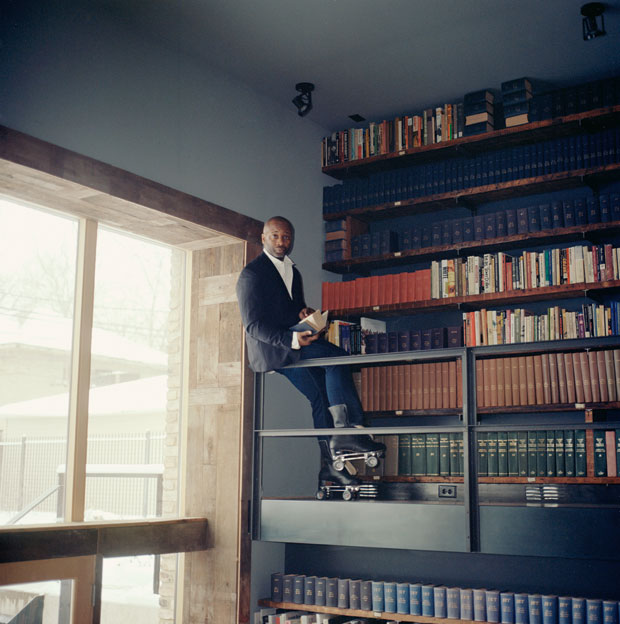
After she leaves, Gates asks if he can read me a poem. He launches into performance mode, declaiming from the spines on a long shelf of black-bound books, each one bearing a line, embossed in silver. ‘For a brief moment / It looked hopeless / Hate seemed victorious / Nothing moved / No one whispered / Not even art…’ The black volumes are in fact bound copies of Jet magazine, a now out-of-print African-American news weekly that Gates recently acquired as part of the archives of the Johnson Publishing Company, after it ceased publication last year. If you know Jet, says Gates, you would recognise the squat dimensions of the volumes immediately. Another complete archive of a Johnson magazine, the black lifestyle monthly Ebony, will appear in ‘The Minor Arts’, bound and shelved in a sculpture titled New Egypt Sanctuary of the Holy Word and Image (2017).
‘I’m interested in having my voice, or my voices, or my voicings, which may need multiple kinds of platforms in order for me to feel like in a day I’ve said everything I wanna say,’ Gates tells me. A central body of work in ‘But to Be a Poor Race’ consists of acrylic paintings of information graphics appropriated from the sociologist W.E.B. Du Bois’ 1903 book The Souls of Black Folk, with all textual information removed. These graphs and charts portray statistical data about the social advancement of African Americans in terms that an academic or a politician might consider appropriate for a scholarly study, but which are also comprehensible to a general audience. ‘This dialectic: what do you say to white abolitionists at the same time you’re talking to brothers and sisters? I’m curious about that,’ says Gates.
Du Bois was the first black person to receive a doctorate from Harvard. As Gates observes, ‘He’s an insider, but for him, he’s still like, “Well I’m up from slavery.”’ Nobody ever feels like an insider, Gates concedes, no matter how much they might seem to be in the middle of things from an outside perspective. Gates may now be an internationally recognised artist represented by major galleries, a tenured professor at the University of Chicago, a community organiser and urban planner who has the ear of Chicago’s mayor Rahm Emanuel and many other powerful figures in the city’s elite, but the experience for insiders like himself or Du Bois is, ‘I’m in the same room, but I’ve never been more different from these people.’
The exhibition’s title is also taken from Du Bois. ‘To be a poor man is hard, but to be a poor race in a land of dollars is the very bottom of hardships,’ he wrote. Gates is no longer a poor man, by any stretch of the imagination, but he thinks about how the hardships of African Americans in the United States have paradoxically nourished a cultural wealth. ‘To be a poor race is actually a point at where a deep richness lives, and could only live in the presence of a certain kind of poverty,’ he says. ‘And I feel that richness slipping away from me. I do.’
That morning, he tells me, he was on the phone with the mother of Tamir Rice, the 12-year-old black boy who was shot dead in 2014 by police in Cleveland, Ohio, for carrying a toy pistol. At the Stony Island Arts Bank he will host an exhibition in memory of Rice. He shared his ideas for the exhibition with Samaria Rice, who had quite specific ideas of her own. Naturally, Gates acquiesced to her wishes. This show was not about him or his work. ‘I like the idea that I can be here preparing for my show on black modernism, and trying to carry over my interest in black modernism to Tamir Rice’s mom from Cleveland Ohio. And she’s saying, I’m not interested in black modernism,’ says Gates. ‘I want to be able to say, I’m no longer an artist in this situation, I’m an enabler.’
Do not confuse Gates’ humility with selflessness. ‘I think it’s always about me,’ he says when I ask him about the centrality of his persona in his apparently altruistic work. ‘I’m never selfless. I’m super clear about these couple of things that I think I was put on earth to do, and sometimes those things have to do with projects outside of myself.’ He summarises: ‘On some level, I’m just looking for good problems to solve. And I don’t have to look far.’
I ask him whether he is conscious of performing his own story, especially in interviews like this one. He responds that, on the contrary, he feels it is often journalists who repeat certain well-worn episodes in his biography, ‘performing a kind of journalism that forces the work to say a particular thing. I’m saying, let’s start with today. This show is up already. Let’s start with my future brick manufacturing company. That’s the sublime!’
Still from My Country ’Tis of Thee. Theaster Gates. Courtesy Regen Projects, Los Angeles; © Theaster Gates
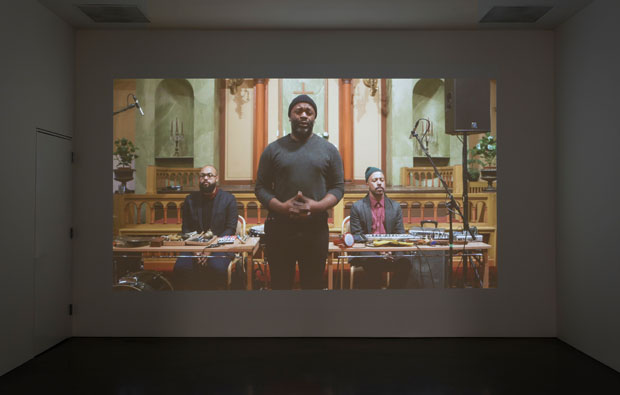
‘In the Tower: Theaster Gates’ is at the National Gallery of Art, Washington, D.C. from 5 March–4 September.
From the March 2017 issue of Apollo. Preview and subscribe here.
